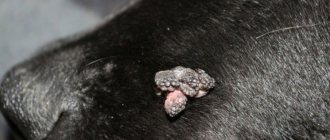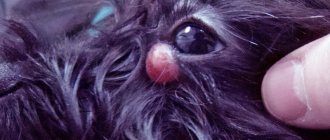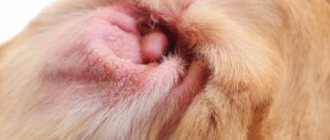There are a number of diseases that, it would seem, do not pose a threat to the dog’s life and are, rather, a cosmetic problem. These diseases include papillomas - tumors of benign origin. However, warts (as papillomas, which are growths on the skin, are popularly called) are far from harmless and pose a serious threat to animal health.
Causes of the disease
The mechanism of pathology development is as follows. Papillomavirus (PV) penetrates the most sensitive cells of the basal layer through cracks in the skin or oral mucosa.
In the affected area, the virus begins to rapidly multiply and reproduce new layers of harmful cells, which actively replace healthy ones. In this way, the papillomavirus invades the basal cells, actively moving towards the surface epithelium.
The infected cell, moving towards the surface, stops dividing, which provokes the virus to stimulate the metabolism and reproduction of the captured cell with transforming proteins.
This, in turn, leads to active cell division, their unlimited growth and transformation into tumor cells. This process leads to the appearance of papillary tumors on the skin or mucous membrane - papillomas. As they grow, they visually become similar to cauliflower.
The virus is unusually stable and persists in the external environment for a long time, so the main reason for the development of the disease is contact with sick individuals, as well as through various care items.
Also, the most likely causes of the pathology include weak immunity and long-term therapy with corticosteroid drugs.
Signs of papillomatosis: what do warts look like?
At first, a wart on a dog’s back has a flat, smooth surface and a rounded shape. As the abnormal cells grow, uneven bumps form.
Warts can be located on:
· Centuries.
· Mucous mouth.
· Genital organs.
· Skin.
· Conjunctiva of the eyes.
The most unpleasant ones are warts in the mouth. The growths prevent the dog from eating, drinking, and chewing. Increased salivation appears, papillomas are often injured, blood appears and a bacterial infection is introduced into the wounds. There is an unpleasant odor coming from the mouth.
In old, weakened pets, warts can degenerate and become malignant.
With a plantar (pad) wart, pronounced lameness appears, the pet tries not to lean on its paw, presses it in or steps carefully. When the growth is injured, blood appears, infection enters the wound and suppuration begins. Therefore, such papillomas need to be removed.
Your dog may have a wart-like growth on his ear. While it is small, it does not cause any special problems for the pet, but as it grows, it can become injured, fester, alopecia, weeping, etc. form around it. It is better to show the dog to a veterinarian in time and, according to indications, remove the wart.
Main symptoms
Papillomas are small cone-shaped neoplasms of a soft and loose consistency, localized mainly on the oral mucosa, less often on the abdomen, paws, vulva and other parts of the body.
At the initial stage, the nodules have a smooth, even surface and a pinkish tint. As the disease progresses, papillomas become dirty gray in color and have jagged edges.
The size of warts varies, sometimes they can reach the size of a bean. Since papillomas are equipped with blood vessels, they are easily damaged and bleed.
Tumors can cause severe discomfort for your dog. It hurts her to chew and swallow, making it difficult to eat. An unpleasant odor emanates from the mouth. The animal refuses to eat, becomes lethargic, and subsequently becomes exhausted.
Warts in dogs
Warts, or scientifically known as papilomatosis, are benign viral neoplasms localized on the skin and mucous membranes of dogs. With this disease, a modification of the epithelial tissue occurs with the formation of nodules and hanging tubercles.
The causative agent of warts in dogs is DNA - a virus that infects dogs with weakened immune systems. Transmission of this virus occurs through close contact with a dog with papilomatosis.
The incubation period for papilomatosis is 1-2 months, after which the virus goes into latent form or warts begin to appear in the infected dog. When the body's defenses are restored, the warts that appear disappear on their own.
Infection from sick dogs is possible through shared toys, feeding bowls, licking various objects, scratches and wounds on the animal’s skin, and the use of common walking areas. This virus can be brought into an apartment on shoes.
The following dogs with weakened immune systems are at risk for this disease:
- Puppies and teenagers.
- Elderly dogs.
- Dogs that have suffered injury, surgery, illness or severe stress.
Warts in dogs can be located on various parts of the body - from the mouth, head area to paws. Warts can be either single or multiple.
How warts form.
The formation of warts in dogs occurs as a result of the virus entering the basal layer of cells through a crack in the mucous membranes. From the basal cells, the virus enters the epithelium, which soon desquamates, resulting in the virus ending up in the external environment. As a result of this process, healthy dogs become infected. As an infected cell moves, its ability to divide into other cells changes. All this does not suit the viral cell, and it stimulates metabolic processes and reproduction with special proteins. As a result of their influence, healthy cells transform into tumor cells. Subsequently, such a tumor cell is able to grow and multiply in the dog without any restrictions.
As a result of this process, small tumors form on the mucous membranes and skin, which are popularly called warts.
In a large number of dogs, the virus itself is present in the body, but does not manifest itself in any way. Coming out of this latent state in a dog can provoke severe stress, weakening of the immune system caused by various diseases, including worms (worms in dogs), ectoparasites (fleas in dogs), and inadequate feeding (basics of feeding dogs).
Can a person become infected with papilomatosis from a sick dog?
There is an opinion that a person who has close contact with a sick dog has the opportunity to “catch” this disease. However, convincing scientific data does not exist today. Today there are more than 600 strains of human papillomavirus, these strains are constantly mutating and changing. It is hypothetically possible that some strains of papilomatosis have become universal and can parasitize dogs and humans.
But if you observe personal hygiene measures, do not have wounds or scratches, do not touch warts and do not wipe off saliva, contact infection is excluded. If there are other dogs in the house and they come into contact in one way or another with a papillomatous dog, then they can actually become infected.
Types of papillomas.
Depending on the location of papillomas on the dog’s body, they are divided into:
Oral – most often occurs in young dogs, they look like white papules in the dog’s mouth, and sometimes appear on the lips or nose.
Skin - are small formations up to 0.5 cm in size. Skin papillomas are most often localized on the head and eyelids of adult dogs.
Transitional cell - have a round shape and are located in the dog’s abdomen and armpits.
Genital – very rare in dogs. The location is the dog's genitals.
Multiple – typical for small breeds of dogs, localized in the form of pigmented plaques on the lower body or thighs. Over time, they become covered with scaly tissue.
Pads - registered in adult dogs on the pads of their paws.
Symptoms of papilomatosis.
At the beginning of the disease, warts have a smooth, even surface and a rounded shape. Subsequently, the pathological cells grow, forming large, uneven “warts”. In a sick dog, warts can appear on the eyelids, conjunctiva of the eyes, oral mucosa, genitals and skin.
When warts are localized in the dog’s mouth, it becomes painful for the dog to chew and drink, the dog develops increased salivation, and an unpleasant odor comes from the mouth. The owner of a dog in such a dog notes traces of blood on the food, the dog’s refusal to take solid food and ultimately exhaustion. With large papillomas, they are constantly injured and become a gateway for infection. Often in such dogs it is necessary to diagnose candidomycosis.
In weakened and old dogs, papillomas can degenerate into a malignant neoplasm.
With warts on the paws, the dog begins to limp or tries not to step on the paw where the wart is.
When the papilloma is injured, the dog begins to bleed and the wound becomes infected.
The diagnosis of papilomatosis is made based on the symptoms of the disease. Additionally, laboratory tests (immunohistological, electron microscopic) can be carried out.
Treatment. Treatment of papilomatosis in dogs depends on the nature of the tumor itself or a group of tumor formations. The method of treating warts is selected by a veterinary specialist at the clinic based on a clinical examination and laboratory tests of the sick dog.
If the dog owner notices that at least one of the papillomas has disappeared without any treatment, then there is a high degree of probability that the remaining papillomas will disappear on their own. If the warts do not disappear, the owners should contact a veterinary clinic.
Medicinal methods for treating warts include:
- Three intravenous injections of 0.5% novocaine with an interval of 3 days. The dose is calculated depending on the dog's weight.
- Injection of novocaine under the base of the papule. The course of treatment consists of 3 injections with an interval of 2-3 days.
- A single injection of novocaine into the base of the papilloma, after which 10% iodoform ether is injected.
- Use of immunomodulators.
- Rub in anti-verrucin paste daily until the wart disappears.
- Treatment with fosprinil (effective against a large number of virus strains)
- Treatment with immunoparasitan in combination with comedon.
When treating with ointments and pastes, it is necessary to wear a cardboard collar on the dog (to prevent the dog from licking the medicine).
Surgical removal of papillomas today is not always considered appropriate, due to the fact that this can cause an even greater spread of papillomatosis. If the papilloma is very large and makes it difficult for the dog to swallow, as a result of which the dog cannot eat properly, then veterinary clinic specialists use modern methods to remove it:
- Cryodestruction - the use of low temperatures. Low temperatures lead to the death of tumor cells and the rejection of warts.
- Electrocoagulation - by exposing the papilloma to currents of a certain frequency.
- Laser removal of papillomas. The operation is carried out through the directed action of a focused laser beam.
Vaccination. The use of a vaccine is considered the most effective treatment for warts in dogs. To prepare it in veterinary clinics, in compliance with the rules of asepsis and antiseptics, they use papilomatous tissue taken from a sick dog. The vaccine obtained in this way is administered subcutaneously to a sick dog twice with an interval of 7-10 days. The therapeutic effect in dogs appears after 3 weeks.
To treat warts, dog owners use a variety of folk remedies. The use of these drugs is justified in the first stages of the disease, when warts are sporadic.
- Lubricating warts with celandine juice (cannot be used on mucous tissues). This procedure is repeated several times a day. For lubrication, use orange juice, which is secreted near the root of the plant. After some time, the surface of the tumor turns black and is cut off with scissors, and treatment continues. The celandine juice is rubbed until the wart completely disappears. Small young warts can be removed using dandelion juice.
- Local application of the ASD-2 fraction in a 50 to 50 mixture with vegetable oil.
- Applying salicylic acid ointment.
- Using a pipette, apply a few drops of apple cider vinegar daily 3-4 times a day until the skin is completely cleansed of warts.
- Rub garlic on warts for several days.
- Applying one drop of vinegar to a wart is no longer possible.
- Using milkweed juice. The principle is approximately the same as when using celandine.
- Bandaging the base of the wart with silk or nylon thread. The area where the constriction will be applied must first be treated with tincture of iodine. The wart, deprived of nutrition, dies.
Prevention. Prevention of papillomatosis should be based on excluding contact of your dog with stray animals, as well as dogs with papillomatosis. Before mating, it is necessary to carefully check the partner. In order to increase immunity, it is necessary to organize nutritious feeding, balanced in vitamins and macro- and microelements. Golden rules for rational feeding of dogs, feeding a lactating dog, feeding pregnant females, feeding an aging dog, feeding puppies.
Diagnostics in a veterinary clinic
Diagnosis includes taking an anamnesis and examining the animal. If papillomas are located in the oral cavity, the veterinarian will detect them immediately. It’s another matter when tumors are formed on the pads and in hard-to-reach places, for example, on the vulva. A dog's thick, long hair can also hinder diagnosis.
To obtain the most complete and reliable information about papillomas, in particular, for detailed immunohistochemical examination, determination of the virus and the presence or exclusion of oncology, biopsy samples will be required. If it is difficult to determine the type of pathogen, PCR (polymerase chain reaction) is used.
A diagnostic method such as electron microscopy can make an accurate diagnosis, but, unfortunately, not every veterinary clinic is equipped with expensive equipment for its implementation.
Which dogs are at risk?
Most often, older dogs and puppies, as well as animals that have suffered injuries and illnesses, are susceptible to infection.
The risk of infection is also increased in some breeds, such as Spitz, Pugs, Terriers, Cocker Spaniels and Miniature Schnauzers.
Treatment method and prognosis
There is no single treatment for papillomas in dogs. For each specific case, the doctor develops an individual scheme based on the dog’s age, health, the nature of the tumor and other factors.
There are cases when papillomas disappear on their own, but if they do not disappear for a long time and grow rapidly, then treatment cannot be avoided.
The most common treatment method is surgery. Types of operations to remove papillomas are as follows:
- cryosurgery - removal of warts by exposure to low temperatures;
- electrocoagulation - removal by electric current;
- laser therapy;
- surgical excision with a scalpel.
Laser removal is a painless and effective method that does not require anesthesia. However, surgical excision is often preferred, since a scalpel can be used to remove growths even in hard-to-reach places. The operation is performed under general anesthesia, as are cryosurgery and electrocoagulation.
The decision regarding the type of operation is made by a specialist. Most often, puppies, young dogs whose age does not exceed 4 years, and individuals with weakened immune systems are exposed to it. For elderly animals over 10 years of age, surgery is performed for medical reasons.
Drug therapy is not as effective as surgery, but sometimes it gives good results, especially if the disease is diagnosed at an early stage. The dog is prescribed immunomodulators, injections of novocaine solution, and the drug “Fosprenil”.
If you go to the veterinary clinic in a timely manner and undergo treatment, the specialists’ prognosis is favorable.
Medicinal forms of treatment
When traditional treatment methods do not provide the desired result and the growth of warts does not stop, there is a need for emergency action. To do this, veterinarians prescribe a course of subcutaneous injections of specially developed drugs that prevent surgical intervention:
- interferon;
- cyclopherene;
- catozal;
- fosprenil;
- novocaine (injected under the base of the papilloma), etc.
The dosage and duration of use of the above medications depend on the degree of infection of the animal and its weight.
Thus, alternating intramuscular injections of cycloferon and catosal in appropriate dosages effectively copes with warts on the dog’s face and entire body.
Among tableted drugs that effectively suppress the virus, it is worth highlighting cobalt chloride-containing drugs, which are red in color and are fed to the animal during meals. The dose and course of treatment are determined by the veterinarian and depend on the form of the disease and the weight of the dog. An alternative may be burnt magnesia.
What to do at home
Many owners prefer to treat papillomas in dogs using traditional methods, without seeking help from specialists. Meanwhile, self-medication is dangerous for your pet’s health and can lead to serious consequences. Traditional methods can be used, but only after consultation with a veterinarian and in combination with conservative therapy (if treatment is medicinal).
You can lubricate warts with celandine juice. The juice that flows near the root of the medicinal plant is used. Over time, the tumor will begin to turn black, after which it is carefully cut off, while treatment of the affected area should continue. Over time, the tumor disappears.
Garlic, dandelion juice, acetic acid, ice, and raw berry mixture have also proven themselves well.
Compliance with preventive measures
To prevent the appearance of warts in dogs, try to keep the immune system in good shape by following a proper diet. This way your pet will be reliably protected from infections.
- If vaccination has not been carried out, any contact with stray animals is excluded.
- In this case, you will have to abandon forced overexposures.
- After each walk, be sure to conduct a thorough check, examining all areas of the skin.
For prevention, we recommend visiting a veterinary clinic at least once a year.
Experienced doctors will always be able to detect the presence of harmful microorganisms and parasites.
Folk remedies
Traditional medicine presents its methods to combat the disease. You can resort to treatment with folk remedies in the initial stages, when the lesion is characterized by single neoplasms :
- Use a nylon or silk thread to tighten the base of the papule, having previously treated the area with iodine. Pathological cells die off as they are deprived of nutrition;
- Rub celandine juice into the affected areas. You will need freshly squeezed orange juice, which is collected at the roots. As a result, the neoplasm turns black, it is cut off and treatment is continued until the growth is completely eliminated;
- Dandelion juice is used to eliminate papillomas;
- rub the affected areas with garlic;
- Vinegar is used in the treatment of tumors. One drop is applied to the affected areas every day before bed;
- dry ice is applied to the sore spot at intervals of three hours;
- for quick treatment, pureed rowan fruits are used;
- papillomas turn black and die from the juice of Euphorbia vine.
It is much more difficult to treat degenerative papilloma - fibrosarcoma. This tumor most often develops on the gums, the mucous membrane of the gums of dogs. Unlike a benign neoplasm, a tumor is characterized by a dense, ulcerated surface. Treatment is excision, but in most cases relapses occur.
What is papilloma
In appearance, papillomas resemble single warts. These loose neoplasms are cone-shaped, scattered throughout the body and literally riddled with capillary filaments, which are very easy to injure. Once damaged, the papilloma will bleed for a long time. If there is a large accumulation of formations on the body, then this is diagnosed as papillomatosis.
Tumor-like growths are most often of benign origin and mainly affect young animals. Those that form on the mucous tissues of the oral cavity (tongue, lips, gums, cheeks) are contagious. They can be transmitted to other animals through saliva. The mature generation of dogs can be affected by papillomas on such parts of the body as the eyes, limbs, eyelids, and neck. They are not dangerous for other representatives of the canine tribe, and appear to be much denser than mucous papillomas and with a keratinized surface.
Vaccination
The most effective method of treating papillomas is vaccination. To prepare the product, virus-infected tissue from a sick dog is used. The drug is administered subcutaneously with a certain interval. As a rule, it is 7-10 days. The effect of vaccination occurs after 3 weeks.
Vaccination











